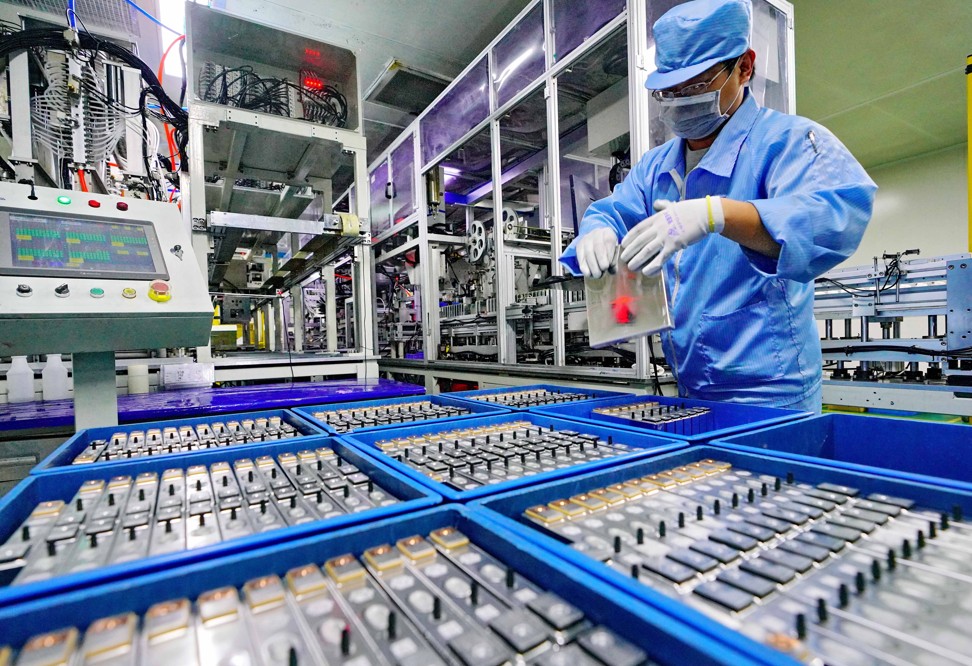China’s belt and road may accelerate exit of manufacturing to Vietnam and India, researchers warn
- The Belt and Road Initiative is China’s plan to grow global trade, but coupled with the US-China trade war, it could add pressure to its sluggish economy and debt pile
- Foreign direct investment in Vietnam’s manufacturing sector, driven by electronics manufacturing, has risen to 11 per cent a year over the past five years

The trade war with the United States coupled with the “Belt and Road Initiative” has the potential to add further pressure to China’s sluggish economy and debt pile, according to researchers, as the benefits of manufacturing in the mainland decrease.
China’s manufacturing industry has already been hit by the US trade tariffs, in particular, the smaller exporters who are the most vulnerable to slowing demand and slimmer margins in the face of competition from low-cost alternatives including Vietnam and India.
Many of China’s competitors in Southeast Asia have already joined the belt and road plan to grow global trade, meaning the manufacturing situation in the mainland is likely to get worse, the researchers said, as investment in the initiative may speed up the exit of low to mid-end production from China to the likes of Vietnam and India despite the benefits of better infrastructure and supply chain.
“The advantages [of producing in China] still exist, but in terms of dynamics, the relative advantages are decreasing as a result of risks and uncertainties coming China-US trade conflict. Of course, the reform process of those countries [Vietnam, India] is also an important factor,” said Xu Qiyuan, an economist at the Institute of World Economics and Politics at the Chinese Academy of Social Sciences.
Foreign direct investment in Vietnam’s manufacturing sector, driven by electronics manufacturing, has risen to 11 per cent a year over the past five years, and it has been a key driver of Vietnam’s export growth, according to data from Oxford Economics.
“Trade agreements and initiatives such as China’s [Belt and Road Initiative] also support investment in the region,” said Sian Fenner, lead Asia economist at Oxford Economics last month.
China is focused on upgrading itself from the “workshop for the world” to one that focuses on hi-tech manufacturing, according to Xu, but the impact of such a transition could be difficult especially considering China is now growing as its slowest rate in more than three decades.
Chinese companies have directly invested more than US$90 billion in countries included in the belt and road plan between 2013 to 2018, according to official data.
The advantages [of producing in China] still exist, but in terms of dynamics, the relative advantages are decreasing as a result of risks and uncertainties coming China-US trade conflict.
“The US-China trade war encourages Beijing to double down on its belt and road activities. Naturally, Beijing will look to substitute some US imports with goods from elsewhere. The longer the US-China trade war lasts, the more China will shift supply chains to other countries, including those participating in the belt and road,” said Jonathan Hillman, a director at the Reconnecting Asia Project and a former policy adviser at the Office of the US Trade Representative.
“A loss for American farmers could be a boon for Kazakhstan and other countries that have been deepening their transportation ties with China through the Belt and Road Initiative.”
However’, China’s own investment in the belt and road plan is also a growing risk for its debt pile and its relations the rest of the world, Xu added.
Instead of the yuan, most the investment in the belt and road plan has been in US dollar, and coupled with US demand for narrowing the trade gap, China’s own foreign exchange reserves are under pressure having declined significantly since 2014.

“If the construction of the belt and road is mainly dependent on the funds provided by China, the drawbacks are obvious. It is easy to be criticised by the international community, including its motives, standards, and influences etc,” said Xu from the Institute of World Economics and Politics, adding that China needs to reduce suspicion and criticism, and the risk of default in its own debt by building the project with developed countries.
Washington has heavily criticised the belt and road plan, warning of the danger of debt traps and threats to national security that the project has brought. But even with the risk of rising tensions with the US and to its own economy in the short term, China is unlikely to give up the plan, researchers said.
“The Trump administration’s stance toward the initiative has been consistently critical, and I don’t expect that to change no matter what happens with the trade negotiations,” said Scott Morris, senior fellow at the Centre for Global Development and director of the US Development Policy Initiative.
“However, to the degree tariffs are contributing to a slowdown in China, they could indirectly slow the pace of investment under belt and road.”